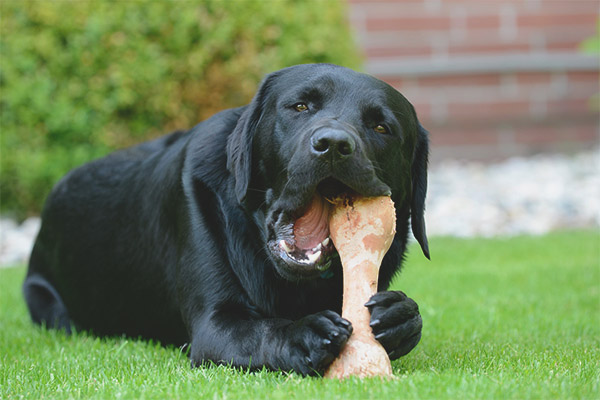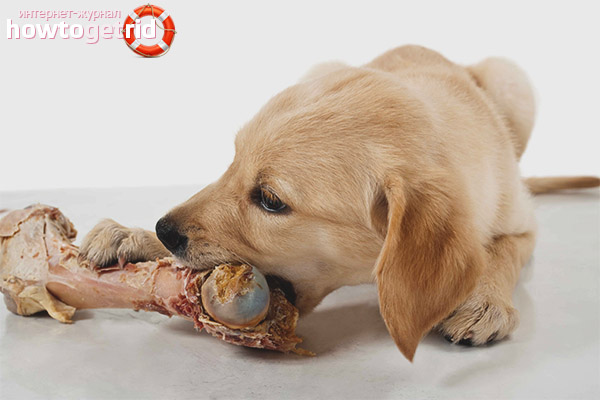The content of the article
Many people perceive feeding dogs with bones as something unacceptable. This is not surprising, because there is an opinion that it is impossible to give a pet a bone. However, any dog that is contained exclusively on the natural menu should also have solid food in its diet. For this reason, periodically, the pet should be given bones, however, it must be done wisely.
What bones can hurt a dog?
Proper diet is important in the life of a dog. It is very important to understand that improper feeding can easily lead to health problems for a pet. Bones in this regard - a very dangerous product. Their fragments may not be removed from the stomach and remain there for more than one year. In some cases, even a harmless bone can carry a danger.For this reason, you need to know which bones should be given to the animal and which ones should not. We have defined a list of bones that are strictly forbidden to give to a pet:
- Chicken bones. It is important to take into account that it is forbidden to give the animal not only the bones of purchased hens, but also domestic ones. There are tubular bones in chickens in the thighs and wings.
- Turkey Bones This bird itself is quite large, moreover, it is usually allowed to be slaughtered in adulthood, at about 2-3 years. During this period, the bones of the animal are already becoming quite strong.
- The bones of the goose. Bones of this animal are considered one of the most dangerous for dogs. Only duck bones can do more harm than them. The fact is that geese are usually slaughtered at the age of one or two years. By this age, the birds have already completely formed bones, which makes them very strong. The broken edges of such bones are very sharp and can easily damage the internal organs of the animal.
- Rabbit. Rabbit bones can also be a serious danger. They are small and very sharp at broken edges. The most dangerous are bones from the hind legs, spine and ribs.If you want to please your pet with tasty rabbit meat, it is better to choose meat or canned meat with cartilage for this purpose.
Many dog lovers cook their pets porridge with the addition of bones. In this case, you can use any bones, however, after preparing the broth, it must be carefully drained and any, even the smallest particles of bones should be removed. Cartilage can be left in the porridge, they are useful for the body of the animal.
What stereotypes do not believe?
The fact that dogs love bones, and cats - only milk and fish products, we are told from early childhood. However, such stories are nothing more than a stereotype. The fault of such stereotypes most adult dog breeders can not even think that the bones can somehow harm their pet and moreover, they can even kill them. It is boring to understand that many stories are just myths that have nothing to do with reality, and such myths need to be debunked:
- A common stereotype is the myth that it is important that a pet has solid food in its diet every day, as it does in wild animals.It does not have to be bones, you can use hard vegetables and fruits. Wild animals have a shorter lifespan, as a rule, they live no longer than eight years. This happens due to the fact that they lose their teeth quite early, as a result of which they cannot eat properly in the future. If you feed your pet feed, then you should not even think about the introduction of solid food into the diet, it is absolutely not necessary.
- Another common stereotype is that an animal needs to sharpen its teeth, therefore bones are necessary for dogs. It is important to understand in this case that the teeth in dogs do not grow throughout life, but always remain the same size, and they do not become dull from food, therefore animals have no need to sharpen them. But the pet can easily damage the tooth enamel about the bone or even break down the canines, causing additional difficulties for themselves in the future.
- Bones need an animal to brush their teeth. In this case, one should start with the fact that only cartilage can help with such a procedure, and it is well-welded. For this reason, many dog lovers introduce into the menu of their pet raw pig bones, legs and ears.However, we should not forget that from such food the animal can become infected with false rabies or other viruses that are absolutely not dangerous for humans, but for the dog they prove deadly. Digestion of cartilage can help in this case, since the heat destroys all bacterial cells. Such an additive in the diet of the animal will be very useful.
- Bones should be given to dogs during the period when their teeth are cut. This stereotype is also very common. Perhaps, in earlier times, the bones did indeed use it to eliminate the itchiness of the animal, but, of course, they did not use tubular bones, but moslaki. Today, there is no need for this, because in any pet store you can find a huge variety of chewing delicacies, which are enough for a very long time. At the same time, they perfectly relieve the puppy from itching. Moslacchi at such an early age also cannot be completely safe, as there is a risk of jaw dislocation or bite damage.
Many people know that the gastric juice in dogs has an increased acidity, which makes the bones softer in just a couple of hours.However, it is important to understand that in this case the bones become a single viscous mass, which also does not bring anything good and can harm. Sharp bones for two hours can easily damage the stomach.
What troubles can a dog have after feeding bones?
If for some reason you decided to feed your pet with bones, for example, relying on the earlier experience of your relatives, you should prepare in advance for the possible consequences that the animal may overtake:
- Various throat injuries. Swallowing sharp bones is very dangerous. A small fragment may not only scratch the inner shell, but also pierce it. Since there are a large number of blood vessels in the pharynx area, the animal may experience internal bleeding. Also, a pet can pierce a trachea, which is also very dangerous.
- Asphyxia. Often the bones get stuck in dogs between chewing teeth. The animal cannot independently pull them out and begins to choke on its own saliva. If he is not helped in time, the pet may die from suffocation.
- Dehydration of the body. These consequences can lead to a large bone stuck in the stomach. Since it does not come out in the traditional way, the stomach begins to react, throwing out the vomit. However, in this way, the bone also cannot come out, as a result, the animal vomits until complete dehydration occurs. To save a pet in this case is possible only with the help of surgical intervention.
- Excessive accumulation of bones in the stomach. This disease affects most stray dogs. As a rule, due to malnutrition in these animals the metabolism is disturbed. As a result of such violations, there is a noticeable decrease in the acidity of the gastric juice. The eaten bones simply do not soften and do not go outside, but remain in the stomach, blocking it. The animal may die from intestinal and gastric obstruction or internal bleeding. Help in this case is also possible only with the help of surgery.
- Perforation of the small intestine. Such a disease can occur when a sharp fragment passes the esophagus and stomach, and then damages the small intestine. As a result, severe bleeding can begin, and then tissue death.
- Closure of the colon. Poorly digested bones can accumulate in the large intestine, blocking it and stopping the emptying process. As a result, the animal experiences discomfort and pain in the process of release of the intestine.
It is important to understand that bone is a mineral structure. The animal's intestines are not able to pull out calcium or other useful substances from the bone, so the use of bones is absolutely useless for a pet.
Video: what bones can and cannot be given to a dog












To send